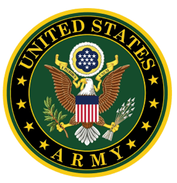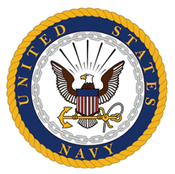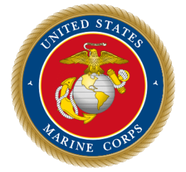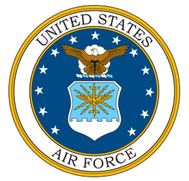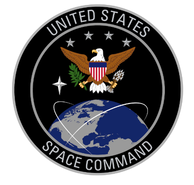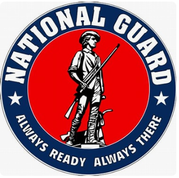Military Service Branches
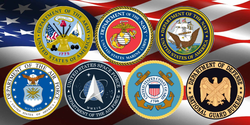
The United States Armed Forces consists of the Army, Navy, Marine Corps, Coast Guard, Air Force and Space Force. The history of the U.S. military goes hand in hand with the history of the country and dates back to the American Revolution.
The Continental Congress established the Continental Army to defend the colonies from the British military and break away from British rule. Immediately after, the Continental Navy and Marine Corps were created to fight the British at sea and on land outside of the colonies.
After the Revolution all three continental forces were disbanded, but Congress decided to establish a permanent military. The Army, Navy, and Marine Corps were followed by the Coast Guard, which started as a service for the Treasury Department. Once the first airplane was invented, the Army established an Aeronautical Division, which eventually became the Air Force. Most recently, with a need to protect U.S. and allied interests in space and to provide space capabilities, the newest service initiated as the Space Force, evolved from the Air Force to meet existing and future challenges in the space domain.
In addition to the six active military services, there is a supporting state-based military service known as the National Guard. Comprised of the Army National Guard and Air Force National Guard, these state services become part of the reserve components of the respective active Army and Air Force branches of service. The National Guard originated from early colonial days where various American colonies stood up state militias. While not a specific branch of the United States (federal) military services, the National Guard is technically the oldest military entity dating prior to the colonies declaring their independence with the first official militia created in 1636 in the Massachusetts colony.
Military Services - Birthdates
United States Army - June 14, 1775
The United States Army was originally founded as the Continental Army on June 14, 1775, which makes the Army the oldest branch of the U.S. military. The Second Continental Congress established the Army so the original 13 colonies could fight British forces during the American Revolution.
The Continental Army lasted until the end of the Revolutionary War and was replaced by the current U.S. Army on June 3, 1784. Congress initially called this new force the First American Regiment and it consisted of 700 men from Pennsylvania, New Jersey, New York and Connecticut. Eight infantry and two artillery companies comprised the regiment.
Motto(s): “This We’ll Defend”
March: “The Army Goes Rolling Along”
The Continental Army lasted until the end of the Revolutionary War and was replaced by the current U.S. Army on June 3, 1784. Congress initially called this new force the First American Regiment and it consisted of 700 men from Pennsylvania, New Jersey, New York and Connecticut. Eight infantry and two artillery companies comprised the regiment.
Motto(s): “This We’ll Defend”
March: “The Army Goes Rolling Along”
The following button links to a new page that was specifically designed for use on an NFC tag (near frequency code) that will be placed on each memorial flagpole. When a visitor phone is placed near the tag on the Army flagpole, their phone will display specific service history, service seal, motto and marching hymn.
United States Navy - October 13, 1775
The United States Navy was established just a few months after the Army on October 13, 1775. The Continental Congress voted to arm two sailing vessels ten carriage guns, as well as swivel guns, and a crew of eighty men. The ships were sent to intercept transports carrying munitions and stores to the British army in America. This was the birth of the Continental Navy, which was needed to push back against the British naval fleet.
After the Revolutionary War, the ships of the Continental Navy were sold, and the seaman were let go. However, the 1794 Congress passed the “Act to provide Naval Armament”. The Act authorized Congress to procure and man six frigates. Three of those frigates, USS United States, USS Constellation, and USS Constitution, were completed and launched in 1797 — these three ships are considered the beginning of the modern Navy.
On 30 April 1798, Congress established the Department of the Navy, to run naval affairs.
Motto(s): “Semper Fortis” (“Always courageous”); and “Non sibi sed patriae” (“Not for self but for country”)
March: “Anchors Aweigh”
After the Revolutionary War, the ships of the Continental Navy were sold, and the seaman were let go. However, the 1794 Congress passed the “Act to provide Naval Armament”. The Act authorized Congress to procure and man six frigates. Three of those frigates, USS United States, USS Constellation, and USS Constitution, were completed and launched in 1797 — these three ships are considered the beginning of the modern Navy.
On 30 April 1798, Congress established the Department of the Navy, to run naval affairs.
Motto(s): “Semper Fortis” (“Always courageous”); and “Non sibi sed patriae” (“Not for self but for country”)
March: “Anchors Aweigh”
The following button links to a new page that was specifically designed for use on an NFC tag (near frequency code) that will be placed on each memorial flagpole. When a visitor phone is placed near the tag on the Navy flagpole, their phone will display specific service history, service seal, motto and marching hymn.
United States. Marines - November 10, 1775
The United States Marine Corps was established on November 10, 1775 to provide extra support to the Continental Navy during the American Revolution. From the beginning, the Marine Corps distinguished itself from the Navy by fighting at sea and on land. The Continental Marines first amphibious battle was at Fort Nassau in the Bahamas. Initially, the Marines were led by Captain Samuel Nicholas, who is considered the first Marine commandant.
After American independence was won, Congress disbanded the Continental Navy and the Marines as well. In the following decade, there was increasing conflict at sea and Congress voted to establish a permanent Marine Corps in May 1798. President John Adams signed the bill on July 11, 1798, and the current U.S. Marine Corps was born.
Motto(s): “Semper Fidelis” (“Always faithful”)
March: “Semper Fidelis” and “The Marine’s Hymn”
After American independence was won, Congress disbanded the Continental Navy and the Marines as well. In the following decade, there was increasing conflict at sea and Congress voted to establish a permanent Marine Corps in May 1798. President John Adams signed the bill on July 11, 1798, and the current U.S. Marine Corps was born.
Motto(s): “Semper Fidelis” (“Always faithful”)
March: “Semper Fidelis” and “The Marine’s Hymn”
The following button links to a new page that was specifically designed for use on an NFC tag (near frequency code) that will be placed on each memorial flagpole. When a visitor phone is placed near the tag on the Marine flagpole, their phone will display specific service history, service seal, motto and marching hymn.
United States Coast Guard - August 4, 1790
The United States Coast Guard traces its history to August 4, 1790 when Congress authorized Secretary of the Treasury Alexander Hamilton’s proposal to build ten cutters to protect the nation’s revenue. The new service, which was under the control of the Treasury Department, had many names including the Revenue-Marine, before being officially called the Revenue Cutter Service in 1863.
One of the earliest jobs of the Revenue Cutters was to suppress piracy and in 1794, the Treasury Department became responsible for maintaining the country’s lighthouses, beacons, buoys, and piers.
Over the years, the Revenue Cutters were given more responsibility, including enforcing maritime laws and helping during conflicts at sea. On January 28, 1915, the Revenue Cutter Service was merged with the Life-Saving Service and the U.S. Coast Guard was formed. The Coast Guard changed again in 1939, when the U.S. Lighthouse Service — which was first established in 1789 — was folded into the Coast Guard’s services. Since then, the Coast Guard has been responsible for maintaining America’s lighthouses.
Motto(s): “Semper Paratus” (“Always ready”)
March: “Semper Paratus”
One of the earliest jobs of the Revenue Cutters was to suppress piracy and in 1794, the Treasury Department became responsible for maintaining the country’s lighthouses, beacons, buoys, and piers.
Over the years, the Revenue Cutters were given more responsibility, including enforcing maritime laws and helping during conflicts at sea. On January 28, 1915, the Revenue Cutter Service was merged with the Life-Saving Service and the U.S. Coast Guard was formed. The Coast Guard changed again in 1939, when the U.S. Lighthouse Service — which was first established in 1789 — was folded into the Coast Guard’s services. Since then, the Coast Guard has been responsible for maintaining America’s lighthouses.
Motto(s): “Semper Paratus” (“Always ready”)
March: “Semper Paratus”
The following button links to a new page that was specifically designed for use on an NFC tag (near frequency code) that will be placed on each memorial flagpole. When a visitor phone is placed near the tag on the Coast Guard flagpole, their phone will display specific service history, service seal, motto and marching hymn.
United States Air Force - September 18, 1947
The United States Air Force was the youngest branch of the U.S. military prior to the creation of a new spin-off service called the U.S. Space Force. The Air Force was created for obvious reasons — the first successful airplane was not built until late 1903 by the Wright Brothers. The Air Force began as the Aeronautical Division of the U.S. Signal Corps on August 1, 1907.
Initially, the Aeronautical Division only had kite balloons, but purchased its first airplane from the Wright Brothers in September 1908.
After this, the Aeronautical Division acquired more aircraft and personnel and got to really test its forces for the first-time during World War I.
In 1926, the Aeronautical Division changed its name to the U.S. Army Air Corps. After the U.S. entered World War II, President Franklin Roosevelt authorized the Air Corps to increase its force to 20,000 planes. The Air Corps proved its prowess during World War II and in 1941 the service changed its name again to the Army Air Forces.
Finally, in 1947, the Air Force established itself as an independent branch of the military.
Motto(s): “Aim High…Fly-Fight-Win”; and “Integrity first, Service before self, Excellence in all we do”
March: “The U.S. Air Force”
Initially, the Aeronautical Division only had kite balloons, but purchased its first airplane from the Wright Brothers in September 1908.
After this, the Aeronautical Division acquired more aircraft and personnel and got to really test its forces for the first-time during World War I.
In 1926, the Aeronautical Division changed its name to the U.S. Army Air Corps. After the U.S. entered World War II, President Franklin Roosevelt authorized the Air Corps to increase its force to 20,000 planes. The Air Corps proved its prowess during World War II and in 1941 the service changed its name again to the Army Air Forces.
Finally, in 1947, the Air Force established itself as an independent branch of the military.
Motto(s): “Aim High…Fly-Fight-Win”; and “Integrity first, Service before self, Excellence in all we do”
March: “The U.S. Air Force”
The following button links to a new page that was specifically designed for use on an NFC tag (near frequency code) that will be placed on each memorial flagpole. When a visitor phone is placed near the tag on the Air Force flagpole, their phone will display specific service history, service seal, motto and marching hymn.
United States Space Force - December 20, 2019
The U.S. Space Force is the youngest military service that organizes, trains, and equips space forces in order to protect U.S. and allied interests in space and to provide space capabilities to the joint force. USSF responsibilities will include developing Guardians, acquiring military space systems, maturing the military doctrine for space power, and organizing space forces to present to our Combatant Commands.
Motto(s): “Semper Supra” ("Always Above")
March: “Invincable Eagle” (**Interim March)
Motto(s): “Semper Supra” ("Always Above")
March: “Invincable Eagle” (**Interim March)
The following button links to a new page that was specifically designed for use on an NFC tag (near frequency code) that will be placed on each memorial flagpole. When a visitor phone is placed near the tag on the Space Force flagpole, their phone will display specific service history, service seal, motto and marching hymn.
National Guard - December 13, 1636
The U.S. recognizes December 13th as the birthday of the National Guard. On this date in 1636, the first militia regiments in North America were organized in Massachusetts. Based upon an order of the Massachusetts Bay Colony's General Court, the colony's militia was organized into three permanent regiments to better defend the colony. Today, the descendants of these first regiments - the 181st Infantry, the 182nd Infantry, the 101st Field Artillery, and the 101st Engineer Battalion of the Massachusetts Army National Guard – share the distinction of being the oldest units in the U.S. military.
December 13, 1636, thus marks the beginning of the organized militia, and the birth of the National Guard's oldest organized units is symbolic of the founding of all the state, territory, and District of Columbia militias that collectively make up today's National Guard.
Five facts concerning the National Guard:
1. The logo’s Minuteman inspiration came from a specific piece of art. In this case, it is the famous Concord Minute Man statue in Concord, Massachusetts. The Minute Man was unveiled in1875 by sculptor Daniel Chester French, and resides near the historic North Bridge in Concord, Massachusetts.
2. The Concord Minute Man is said to represent the Massachusetts colony’s militia and its first three regiments, the 181st Infantry, the 182nd Infantry, the 101st Field Artillery, and the 101st Engineer Battalion of the Massachusetts Army National Guard – these groups share the distinction of being the oldest units in the U.S. military and the beginning of the National Guard.
3. The Minutemen upon which the image/statue is based were townspeople, mostly farmers. This is depicted by the Minute Man who has lowered his plow, raised his rifle and is stepping forward towards the impending battle. Additionally, the plow is a symbol for the land he and fellow Minutemen were defending.
** Look carefully at the National Guard logo, at the foot of the minuteman "farmer" is the plow used to till the farmers' fields.
4. The Minute Man’s pose was loosely based upon that of the Apollo Belvedere that resides in Vatican City. Apollo Belvedere has for centuries epitomized ideals of aesthetic perfection for Europeans and westernized parts of the world.
5. With the success and fame of Minute Man statue, Daniel French became a nationally known and highly-sought-after sculptor, going on to design the Lincoln Memorial.
Motto(s): “Always Ready, Always There!"
March: “Always Ready, Always There!"
December 13, 1636, thus marks the beginning of the organized militia, and the birth of the National Guard's oldest organized units is symbolic of the founding of all the state, territory, and District of Columbia militias that collectively make up today's National Guard.
Five facts concerning the National Guard:
1. The logo’s Minuteman inspiration came from a specific piece of art. In this case, it is the famous Concord Minute Man statue in Concord, Massachusetts. The Minute Man was unveiled in1875 by sculptor Daniel Chester French, and resides near the historic North Bridge in Concord, Massachusetts.
2. The Concord Minute Man is said to represent the Massachusetts colony’s militia and its first three regiments, the 181st Infantry, the 182nd Infantry, the 101st Field Artillery, and the 101st Engineer Battalion of the Massachusetts Army National Guard – these groups share the distinction of being the oldest units in the U.S. military and the beginning of the National Guard.
3. The Minutemen upon which the image/statue is based were townspeople, mostly farmers. This is depicted by the Minute Man who has lowered his plow, raised his rifle and is stepping forward towards the impending battle. Additionally, the plow is a symbol for the land he and fellow Minutemen were defending.
** Look carefully at the National Guard logo, at the foot of the minuteman "farmer" is the plow used to till the farmers' fields.
4. The Minute Man’s pose was loosely based upon that of the Apollo Belvedere that resides in Vatican City. Apollo Belvedere has for centuries epitomized ideals of aesthetic perfection for Europeans and westernized parts of the world.
5. With the success and fame of Minute Man statue, Daniel French became a nationally known and highly-sought-after sculptor, going on to design the Lincoln Memorial.
Motto(s): “Always Ready, Always There!"
March: “Always Ready, Always There!"
